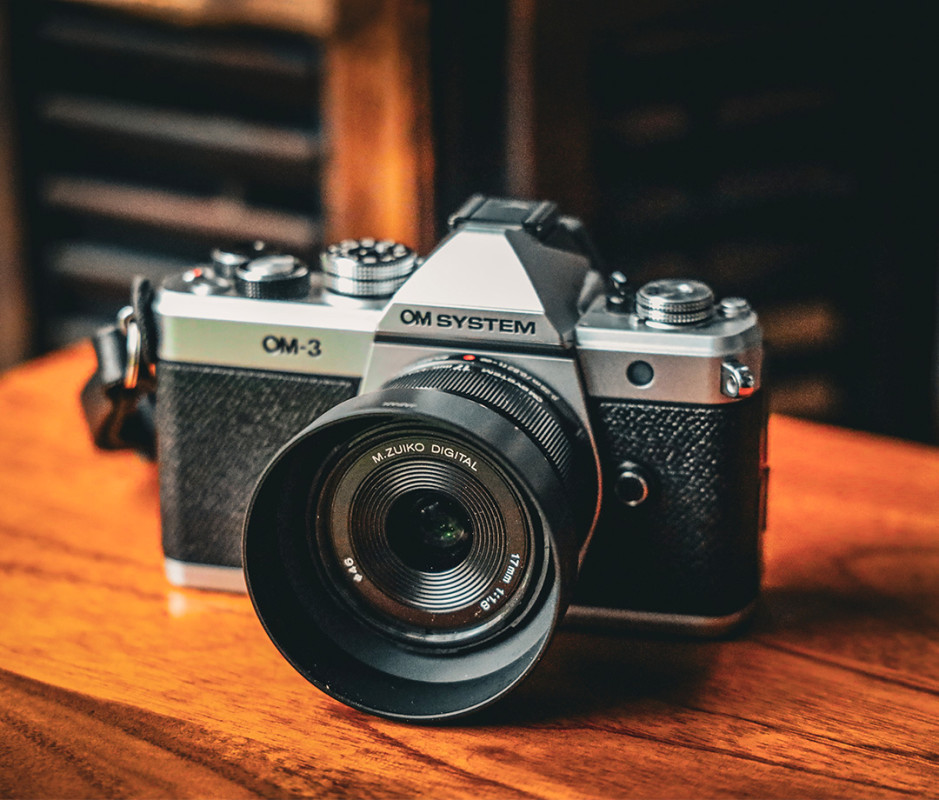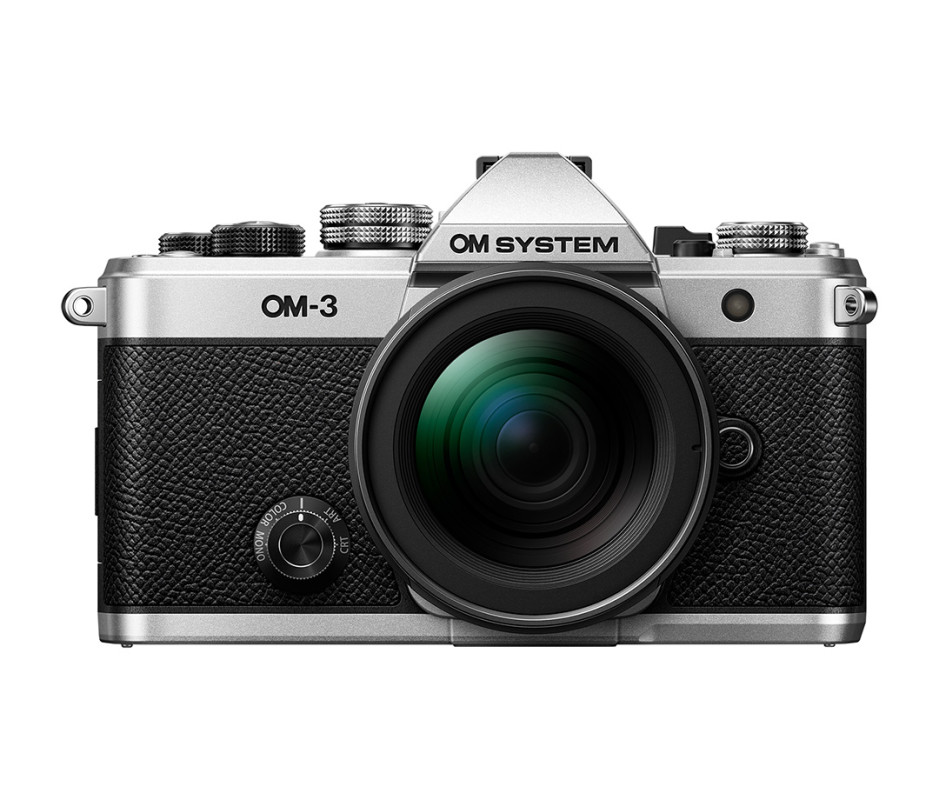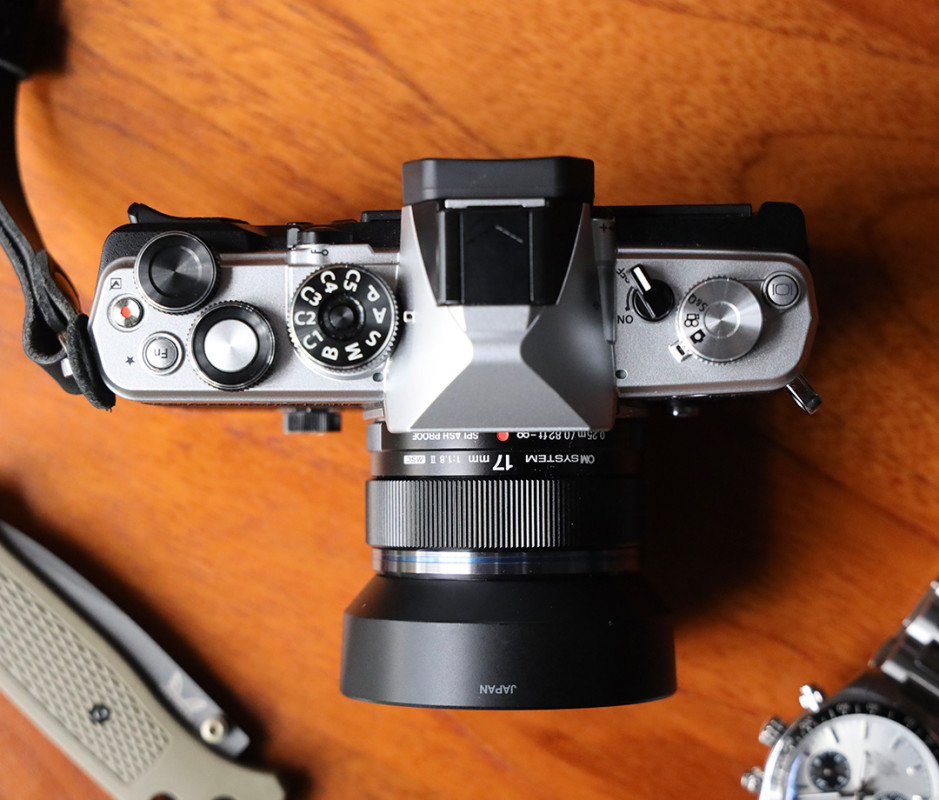OM System (formerly Olympus) cameras are known for their excellence as wildlife and adventure cameras because they’re weather sealed, they have excellent autofocus, and they can shoot extremely fast to catch that perfect shot of a bird on the wing. Because Micro Four Thirds lenses are so much smaller than full-frame lenses, they’re easy to pack on your adventures. The OM-3 takes OM’s flagship digital camera internals and packs them into a vintage replica of Olympus’ own OM-1 35mm camera first released in 1972.
Men’s Journal aims to feature only the best products and services. We update when possible, but deals expire and prices can change. If you buy something via one of our links, we may earn a commission.
What It Is

Stinson Carter
The OM-3 is a modern camera with vintage looks that combines elegant design with blazing modern camera performance. Compact, rugged, and good-looking, it’s an interchangeable-lens Micro Four Thirds camera with a 20MP stacked sensor, In-Body-Image-Stabilization, IPS53 weather sealing, and it can shoot video up to 4K at 60fps and still RAW images at up to 120fps. The well-made metal camera body has an MSRP of $2,000, or $2,300 with an excellent kit lens.
Overall Impressions of the OM-3 Camera
Looks are not everything, but they sure help the OM-3. Sometimes I don’t mind looking like paparazzi with a conspicuous camera in hand, but other times I need something that looks more like a style accessory, so it doesn’t put people on their guard; a svelte vintage-looking camera that I can have on a thin leather strap and take to dinner and leave on the table. The OM-3 gives me that split personality where I can shift between photojournalist and stealthy street photographer.

Stinson Carter
Across the board, I have loved the pictures that I get out of this, and even though I also own a full-frame camera, I have been using the OM-3 exclusively because the brains inside it give me more creative tools to work with—the computational and creative modes that let you do things on the fly that in the past you’d have to do later with editing software.

Stinson Carter
Overall, my biggest surprise is that I have not noticed any reduction in quality stepping down to a smaller sensor from my full frame camera. Because of the creative and computational features of the OM-3, using it saves me time with how much I don’t have to edit photos before posting or publishing them. And as someone who loves great design, the feel of this camera in hand or the look of it sitting on your desk never gets old.
Key Features and Tech

Courtesy Image
The OM-3 is a Micro Four Thirds (MFT) camera, a category named for its sensor size and made primarily by OM System and Panasonic. The two brands are part of a Micro Four Thirds Alliance allowing any MFT lens to work on any MFT camera body. This means that you can use MFT lenses from OM System, Panasonic Lumix, and Leica, and third-party manufacturers interchangeably. This versatility can come in handy when you’re building a lens collection on the used market. While there are some computational features on the OM-3 that only work with specific OM System lenses, I tested the OM-3 with native OM lenses as well as lenses from Lumix and Leica, all with excellent results.
The Computational Photography features on the OM-3 are easy-to-use smart modes that help you get the most out of your hardware. Here’s a common scenario: you take the same picture with an expensive camera and your smartphone, but the smartphone gets a better shot with worse hardware. That’s because companies like Apple and Samsung have put so much money into their camera software that they can maximize the potential of smartphone cameras in ways that you’d have to be an expert photographer and photo editor to match. Think of the OM-3’s computational modes like software shortcuts to make your shots better, to give you more creative options, and for many users, to remove the need to do any photo editing at all.

Courtesy Image
Here’s a few examples of the OM-3’s computational modes: the Gradient ND Filter gives you a moveable dividing line across your photo if you need two different exposures in the same frame—like shooting into a bright sky where you want the ground and the sky perfectly exposed; the Live ND Filter simulates putting a dark filter on your lens, allowing you to use slow shutter speeds that make running water look silky smooth; the Stacked Focus Mode takes eight shots rapid-fire at different focus points and then combines them all into one super-sharp image. These are just a few of the ways that the OM-3 lets you hack your way to better photography with its smart software.
Creative Modes are like color recipes that give your photos a broad range of different looks. This is nothing new; Fuji users have been toggling between different film looks for years. But I like the way they work with the OM-3. You can choose one of the different pre-programmed options for color or black and white, or create your own custom recipes, and then easily swap between them with a physical dial on the front of the camera.

Courtesy Image
I had fun going on YouTube and finding color recipes that look like specific vintage film stock, then saving that as a custom look that I can easily switch to any time I want—with every aspect of color and exposure dialed in and ready. If you shoot your images in the RAW format, you can apply creative modes afterwards, pick your favorite, then export it wirelessly to your smartphone via the OM app—another way the OM-3 helps eliminate the need for editing software.
Weather sealing and In-Body Image Stabilization make the OM-3 more versatile than it looks. With weather sealing, you can take it on a hike or a camping trip and not worry about moisture getting in. With in-body stabilization, you get steadier video and the ability to shoot handheld with longer exposures and still get sharp images.
Pros
- Computational Photography Modes are like photography hacks
- Excellent battery life, I mean really good
- Superb build quality makes you want to hold it in your hand
- Small lenses make it great for travel and adventure
- Blazing fast shooting speed makes it ideal for capturing wildlife
Cons
- Limitations in low light relative to larger APS-C and Full Frame sensors
- Less background blur than larger sensors at the same aperture
- Expensive; the sexy metal construction comes at a price
- Lack of grip makes it unbalanced with larger lenses
Final Verdict

Stinson Carter
If you’re just looking for a compact kit for adventure photography and looks aren’t everything, then save some money and get the new OM-5 Mark II. But, if you want something that looks and feels beautiful in hand or slung on your shoulder, the OM-3 is an under-the-radar gem. In a field where the Fujifilm X100-series and the Leica Q-series tend to get all the love, having used all three I can safely say that the OM-3 more than holds its own and has a few tricks up its sleeve that the others don’t have.
I recommend picking it up as a kit with the 12-45mm f4 PRO lens, which in Full Frame terms is 24-90mm. For your next lens, I recommend getting one of OM’s new weather-sealed and ultra compact prime lenses, either the 17mm 1.8 II (35mm equivalent) and/or the 25mm 1.8 II (50mm equivalent), both of which make the OM-3 a professional and jacket-pocketable content creation tool for photos and video.
Why You Should Trust Me
I’ve been testing and reviewing cameras for the better part of the last decade, using them professionally as a journalist and as an avid hobbyist. I spent six months testing the OM-3, including on trips to Chile, Scotland, Ireland, and Wyoming. Over that time, I’ve lugged it to a Patagonian waterfall, I’ve thrown it in a dry bag while fly-fishing on the Snake River, I’ve shot in dark whisky barrel houses in the Scottish Highlands, and I’ve thrown a telephoto lens on it and photographed golfers at The Open. Every trip has given me a new reason to love it.
Related: Best GMT Watches of 2024 for Men Who Travel the World
